Flow Pattern and Resistance Characteristics of Gas–Liquid Two-Phase Flow with Foam under Low Gas–Liquid Flow Rate
Abstract
:1. Introduction
2. Experimental System
3. Data Processing Method
4. Flow Pattern Analysis of Two-Phase Flow
4.1. Flow Pattern of Two-Phase Flow in Horizontal Pipe
4.1.1. Image Processing
4.1.2. Probability Density Function Graph
4.2. Two-Phase Flow Pattern in Inclined Upward Pipe
4.2.1. Tilt Up 10°
4.2.2. Tilt Up 20°
5. Two-Phase Flow Resistance Characteristics
5.1. Horizontal Pipe Resistance Study
5.1.1. Variation of Pressure Drop under Different Flow Rates
5.1.2. Horizontal Pipe Pressure Drop Calculation Model
5.2. Research on the Resistance of Inclined Upward Pipe
5.2.1. Variation of Pressure Drop under Different Flow Rates
5.2.2. Inclined Upward Pressure Drop Calculation Model
6. Conclusions
- (1)
- The comparison of the PDF diagrams obtained using stainless steel pipes and transparent tubes reveals that as long as the gas–liquid flow rate remains unchanged, the shape of the PDF remains basically unchanged in both stainless steel and transparent tubes. Meanwhile, the comparison of the image recognition results and the PDF determines the flow pattern under the gas and liquid flow rates.
- (2)
- Aiming at the actual operating range of the gas and liquid parameters in the existing application of air foam flooding, gas–water two-phase flow pattern experiments with a foaming agent were conducted. The results show that when the liquid and flow rates do not exceed 1 and 4 m3/h, respectively, in the horizontal pipe, the flow pattern at this time is stratified flow. The flow pattern is slug flow when the pipeline is inclined upward by 10° and 20°, the experimental liquid flow does not exceed 1 m3/h, and the gas flow does not exceed 4 m3/h.
- (3)
- According to the experimental results, in the case of horizontal pipelines, the pressure drop increases with the gas flow rate. Under the same gas–liquid flow, the pressure drop increases with the pipeline pressure. When the pipeline is inclined upward, the pressure drop will increase with the inclination angle under the same pressure and gas–liquid flow. At the same tilt angle, as the pressure increases, the pressure drop will increase with the gas flow, and the pressure drop will decrease.
- (4)
- On the basis of the experimental results, this paper establishes the calculation correlation equations for the gas–liquid two-phase flow resistance and the pressure drop in the horizontal and upward-inclined pipes. Compared with the experiment, the error result of the calculation is small. Therefore, under this condition, it can be used to predict the flow resistance in real air foam flooding. In this paper, the research on two-phase flow resistance with foam has expanded the research direction of two-phase flow. In addition to obtaining the resistance variation rule, it can also play a guiding role in the future process design of air foam flooding. However, there are some limitations in this experiment. The length of the pipeline in the experimental section is short, which is quite different from the length of the pipeline in the actual production process. We will carry out the corresponding measurement in the future actual production process to verify and modify the established resistance prediction model.
Author Contributions
Funding
Institutional Review Board Statement
Informed Consent Statement
Data Availability Statement
Conflicts of Interest
Nomenclature
| pipeline cross-sectional area | |
| diameter of the pipeline | |
| gravitational acceleration | |
| mass flow of the mixture | |
| liquid holdup | |
| frequency of occurrence of sub-samples | |
| number of parent neutron samples | |
| static/mean pressure | |
| total pressure | |
| probability density value | |
| Reynolds number | |
| velocity of mixture | |
| gas conversion rate | |
| vector direction | |
| Greek symbols | |
| the drag coefficient along the path | |
| density | |
| dip of pipe | |
| Subscripts | |
| referred to liquid | |
| referred to gas |
References
- Lang, L.; Li, H.; Wang, X.; Liu, N. Experimental study and field demonstration of air-foam flooding for heavy oil EOR. J. Pet. Sci. Eng. 2019, 185, 106659. [Google Scholar] [CrossRef]
- Liu, P.; Zhang, X.; Wu, Y.; Li, X. Enhanced oil recovery by air-foam flooding system in tight oil reservoirs: Study on the profile-controlling mechanisms. J. Pet. Eng. 2017, 150, 208–216. [Google Scholar] [CrossRef]
- Zhang, C.; Wang, P.; Song, G. Study on enhanced oil recovery by multi-component foam flooding. J. Pet. Sci. Eng. 2019, 177, 181–187. [Google Scholar] [CrossRef]
- Fried, A.N. The Foam Drive Process for Increased Recovery of Oil; Report #5866; United States Bureau of Mines: Washington, DC, USA, 1961.
- Bernard, G.G.; Holm, L.W. Effect of Foam on Permeability of Porous Media to Gas. Soc. Pet. Eng. J. 1964, 4, 267–274. [Google Scholar] [CrossRef]
- Jensen, J.A.; Fried, F. Physical and chemical effects of an oil phase on the propagation of foam in porous media. Soc. Pet. Eng. 1987. [Google Scholar] [CrossRef]
- Telmadarreie, A.; Trivedi, J. Insight on Foam/Polymer Enhanced Foam Flooding for Improving Heavy Oil Sweep Efficiency. In Proceedings of the World Heavy Oil Congress 2015, Edmonton, AB, Canada, 24–26 March 2015. [Google Scholar]
- Telmadarreie, A.; Trivedi, J.J. Post-Surfactant CO2 Foam/Polymer-Enhanced Foam Flooding for Heavy Oil Recovery: Pore-Scale Visualization in Fractured Micromodel. Transp. Porous Media 2016, 113, 717–733. [Google Scholar] [CrossRef]
- Manan, M.A.; Farad, S.; Piroozian, A.; Esmail, M.J.A. Effects of Nanoparticle Types on Carbon Dioxide Foam Flooding in Enhanced Oil Recovery. Pet. Sci. Technol. 2015, 33, 1286–1294. [Google Scholar] [CrossRef]
- Bayat, A.E.; Rajaei, K.; Junin, R. Assessing the effects of nanoparticle type and concentration on the stability of CO2 foams and the performance in enhanced oil recovery. Colloids Surf. A Phys. Eng. Asp. 2016, 511, 222–231. [Google Scholar] [CrossRef]
- San, J.; Wang, S.; Yu, J.; Liu, N.; Lee, R. Nanoparticle-Stabilized Carbon Dioxide Foam Used in Enhanced Oil Recovery: Effect of Different Ions and Temperatures. Spe J. 2017, 22, 1416–1423. [Google Scholar] [CrossRef]
- Singh, R.; Mohanty, K.K. Study of Nanoparticle-Stabilized Foams in Harsh Reservoir Conditions. Transp. Porous Media 2018, 131, 135–155. [Google Scholar] [CrossRef]
- Ewing, M.E.; Weinandy, J.J.; Christensen, R.N. Observations of Two-Phase Flow Patterns in a Horizontal Circular Channel. Heat Transf. Eng. 1999, 20, 9–14. [Google Scholar]
- Weisman, J.; Duncan, D.G.J.C.T.; Gibson, J.; Crawford, T. Effects of fluid properties and pipe diameter on two-phase flow patterns in horizontal lines. Int. J. Multiph. Flow 1979, 5, 437–462. [Google Scholar]
- Weisman, J.; Kang, S.Y. Flow pattern transitions in vertical and upwardly inclined lines. Int. J. Multiph. Flow 1981, 7, 271–291. [Google Scholar] [CrossRef]
- Kokal, S.L.; Stanislav, J.F. An experimental study of two-phase flow in slightly inclined pipes—I. Flow patterns. Chem. Eng. Sci. 1989, 44, 665–679. [Google Scholar] [CrossRef]
- Rafalko, G.; Mosdorf, R.; Gorski, G. Two-phase flow pattern identification in minichannels using image correlation analysis. Int. Commun. Heat Mass Transf. 2020, 113, 104508. [Google Scholar] [CrossRef]
- Do Amaral, C.E.; Alves, R.F.; da Silva, M.J.; Arruda, L.V.; Dorini, L.; Morales, R.E.; Pipa, D.R. Image processing techniques for high-speed videometry in horizontal two-phase slug flows. Flow Meas. Instrum. 2013, 33, 257–264. [Google Scholar] [CrossRef]
- Cely, M.M.H.; Baptistella, V.E.; Rodriguez, O.M. Study and characterization of gas-liquid slug flow in an annular duct, using high speed video camera, Wire-Mesh Sensor and PIV. Exp. Fluid Sci. 2018, 98, 563–575. [Google Scholar] [CrossRef]
- Wang, J.; Lu, T.; Deng, J.; Liu, Y.; Lu, Q.; Zhang, Z. Experimental investigation on pressure oscillation induced by steam lateral injection into water flow in a horizontal pipe. Int. J. Heat Mass Transf. 2019, 148, 119024. [Google Scholar] [CrossRef]
- Rodrigues, R.L.; Cozin, C.; Naidek, B.P.; Neto, M.A.M.; da Silva, M.J.; Morales, R.E. Statistical Features of the Flow Evolution in Horizontal Liquid-Gas Slug Flow. Exp. Fluid Sci. 2020, 119, 110203. [Google Scholar] [CrossRef]
- Orkiszewski, J. Predicting Two-Phase Pressure Drops in Vertical Pipe. J. Pet. Technol. 1967, 19, 829–838. [Google Scholar] [CrossRef]
- Beggs, D.H.; Brill, J.P. A Study of Two-Phase Flow in Inclined Pipes. J. Pet. Technol. 1973, 25, 607–617. [Google Scholar] [CrossRef]
- Imamura, Y.; Yamada, H.; Ikushima, T.; Shakutsui, H. Pressure Drop of Gas-Liquid Two-Phase Flow in a Large Diameter Vertical Pipe. Res. Mem. Kobe Tech. Coll. 2006, 44, 19–24. [Google Scholar]
- Hayashi, K.; Kazi, J.; Yoshida, N.; Tomiyama, A. Pressure drops of air-water two-phase flows in horizontal U-bends. Int. J. Multiph. Flow 2020, 131, 103403. [Google Scholar] [CrossRef]
- Bhagwat, S.M.; Ghajar, A.J. A flow pattern independent drift flux model based void fraction correlation for a wide range of gas–liquid two phase flow. Int. J. Multiph. Flow 2014, 59, 186–205. [Google Scholar] [CrossRef]
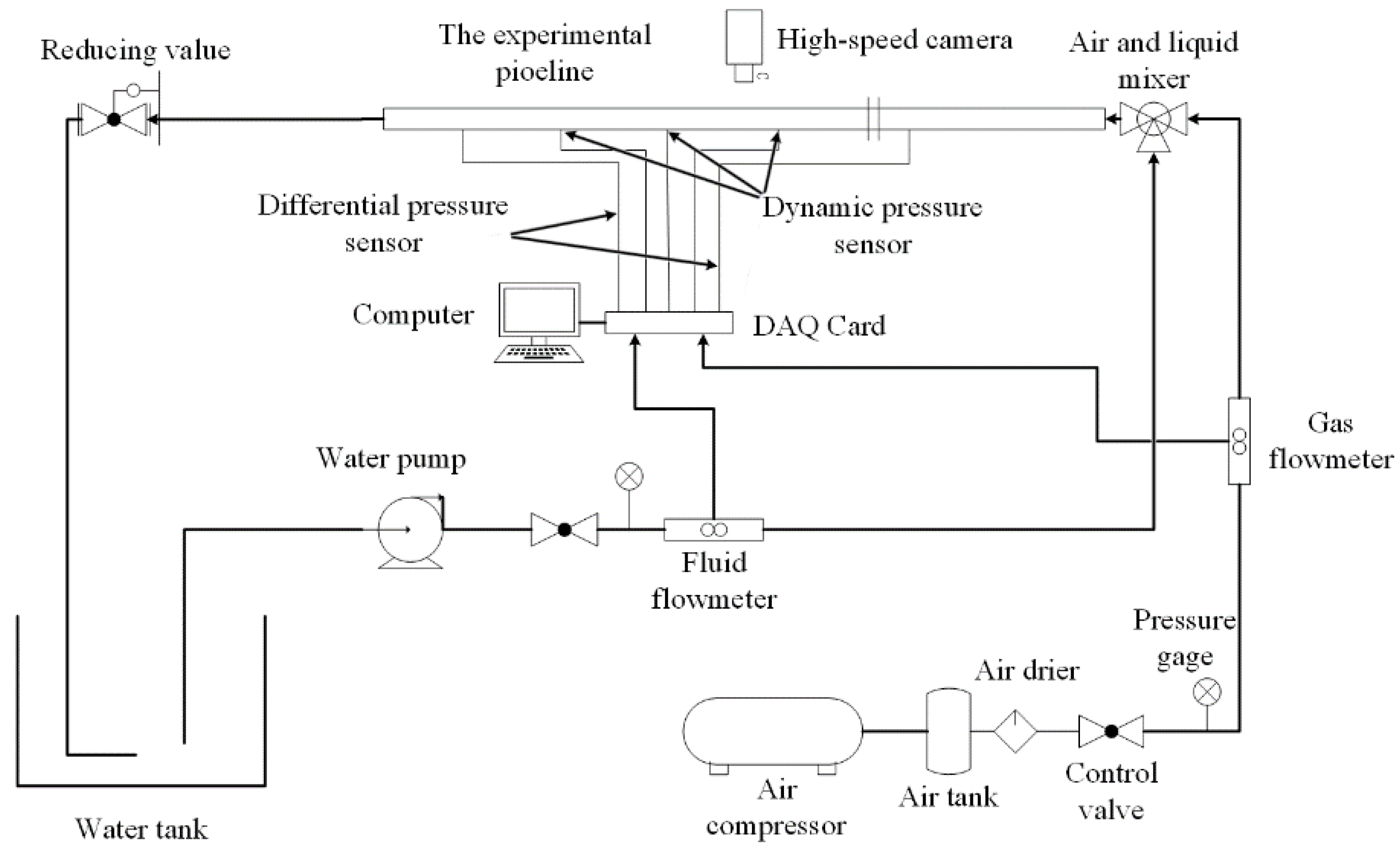


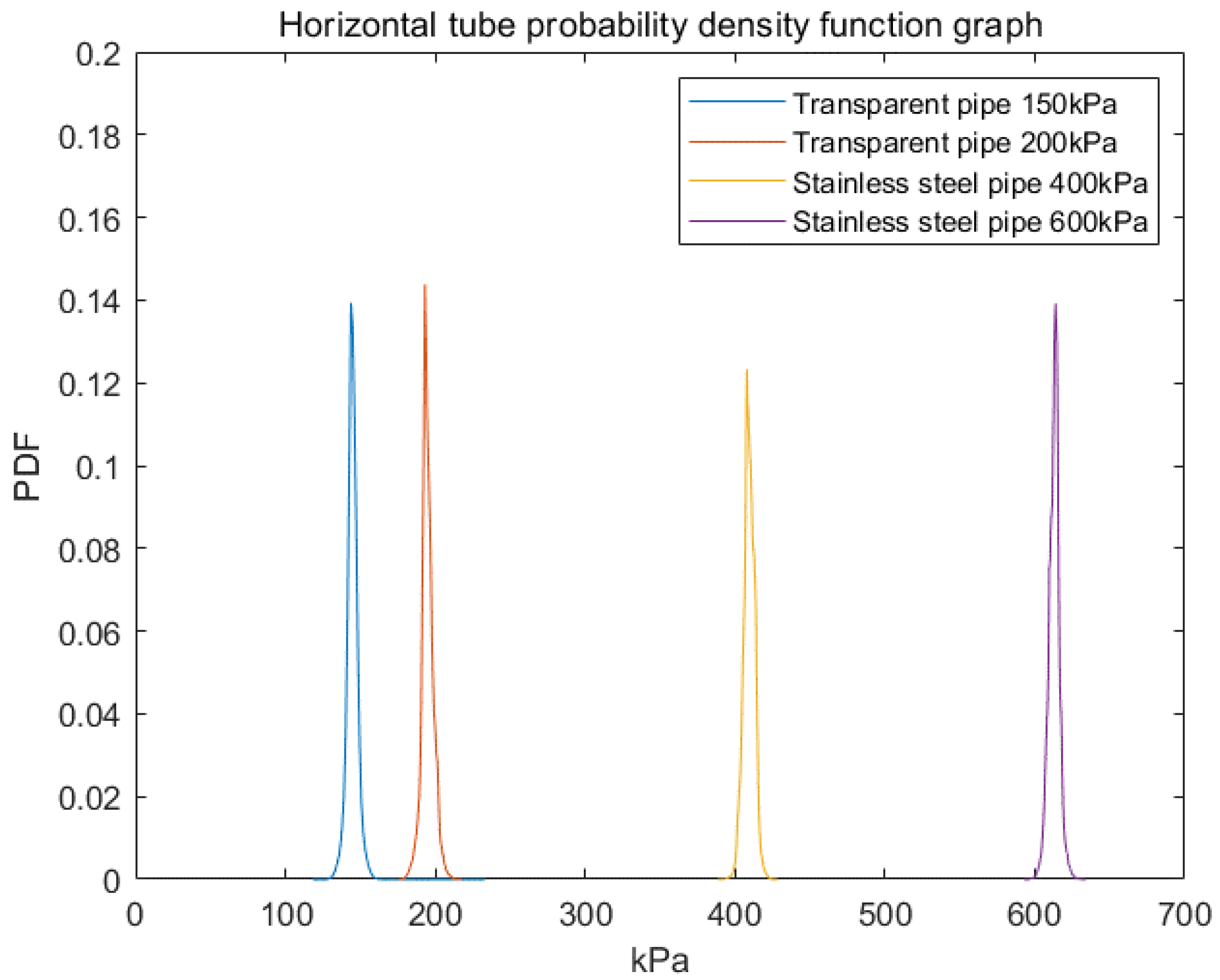
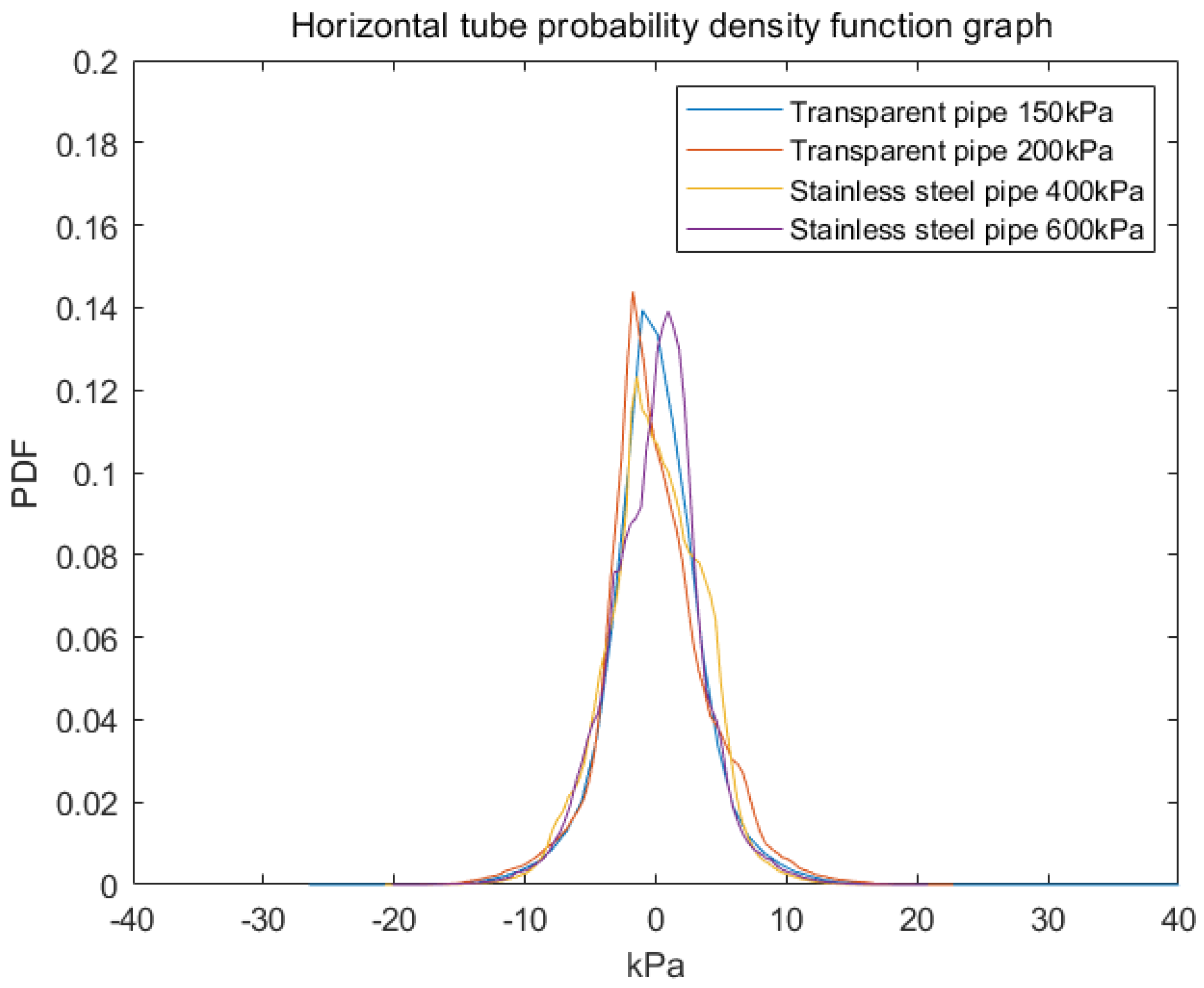


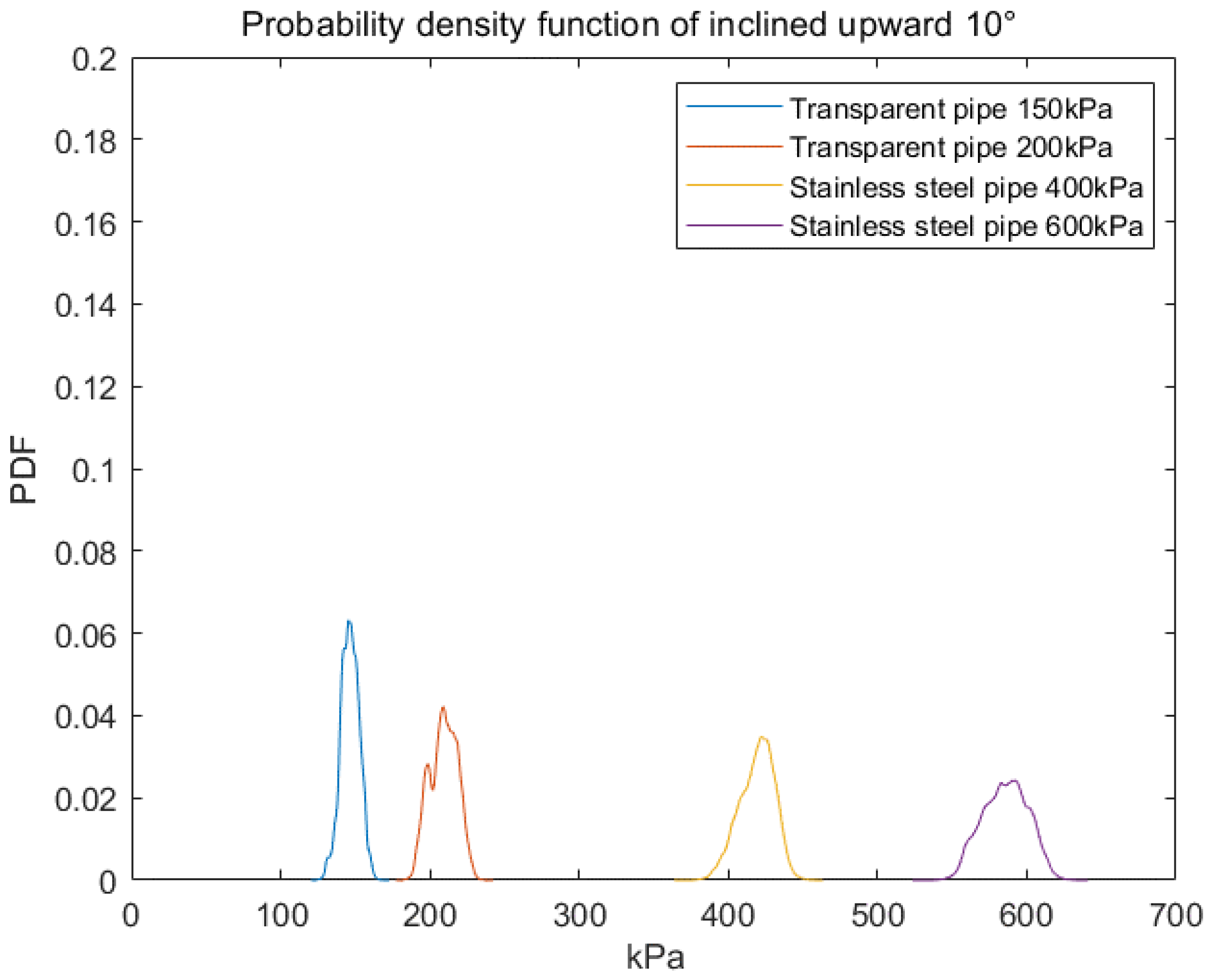
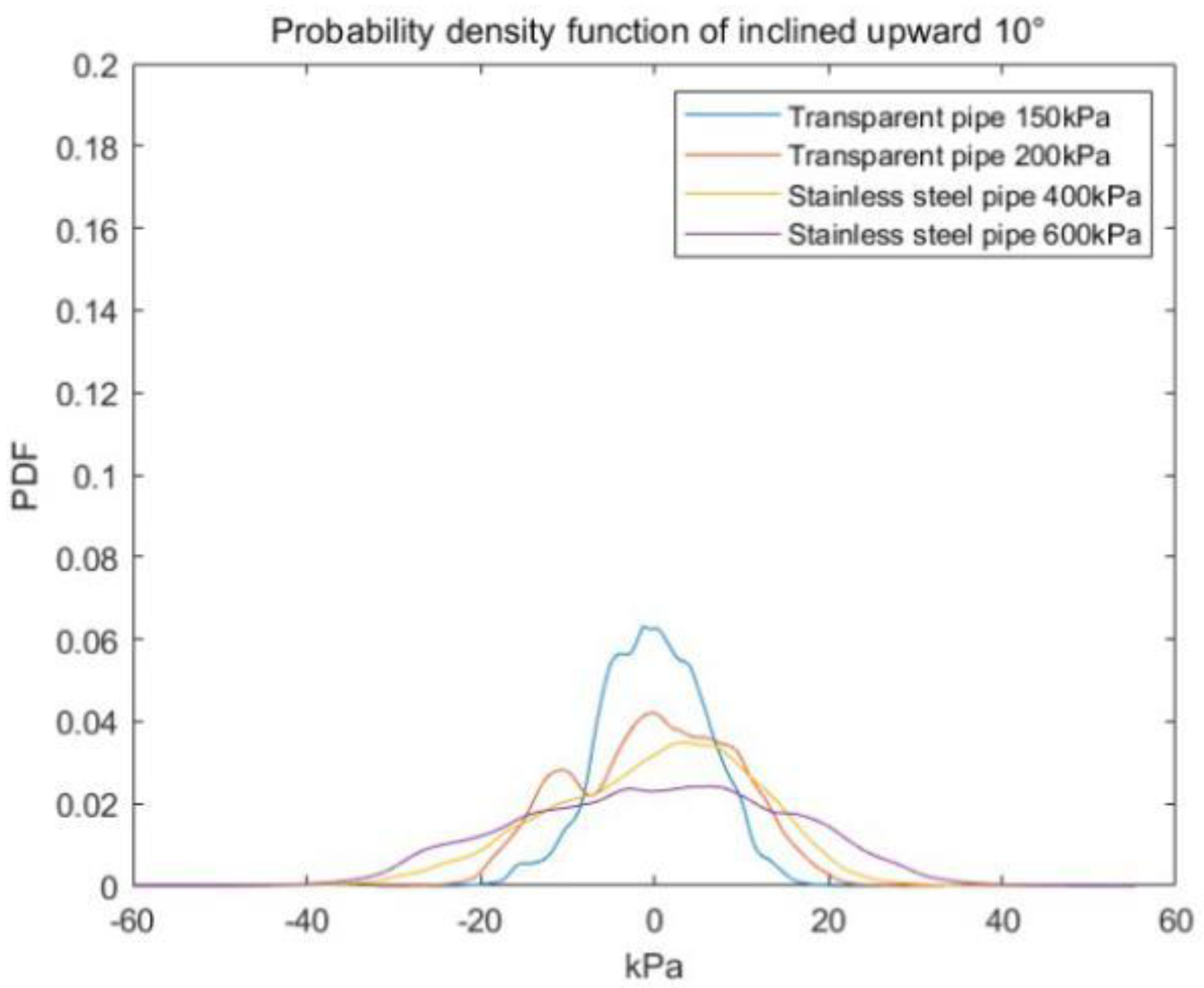


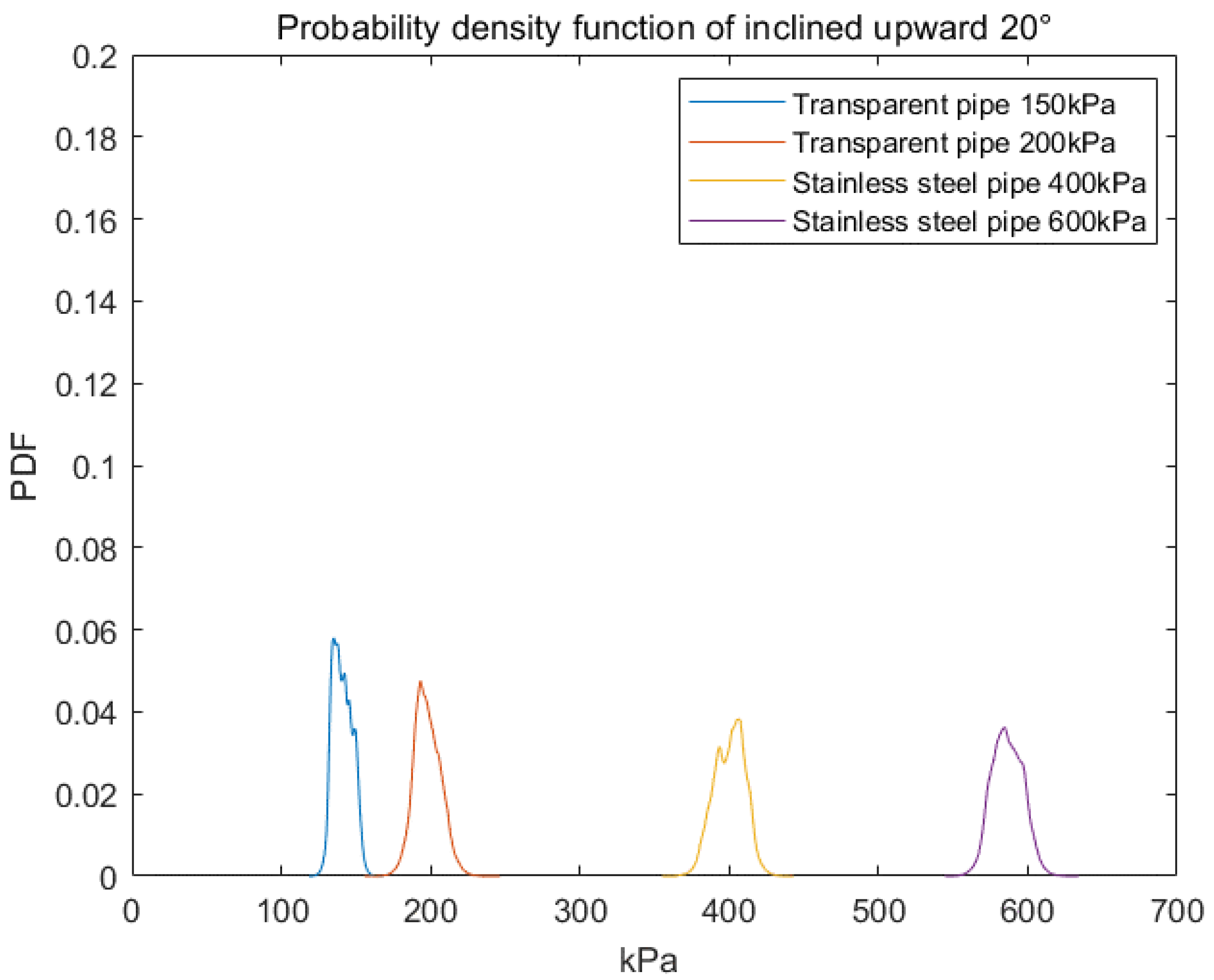

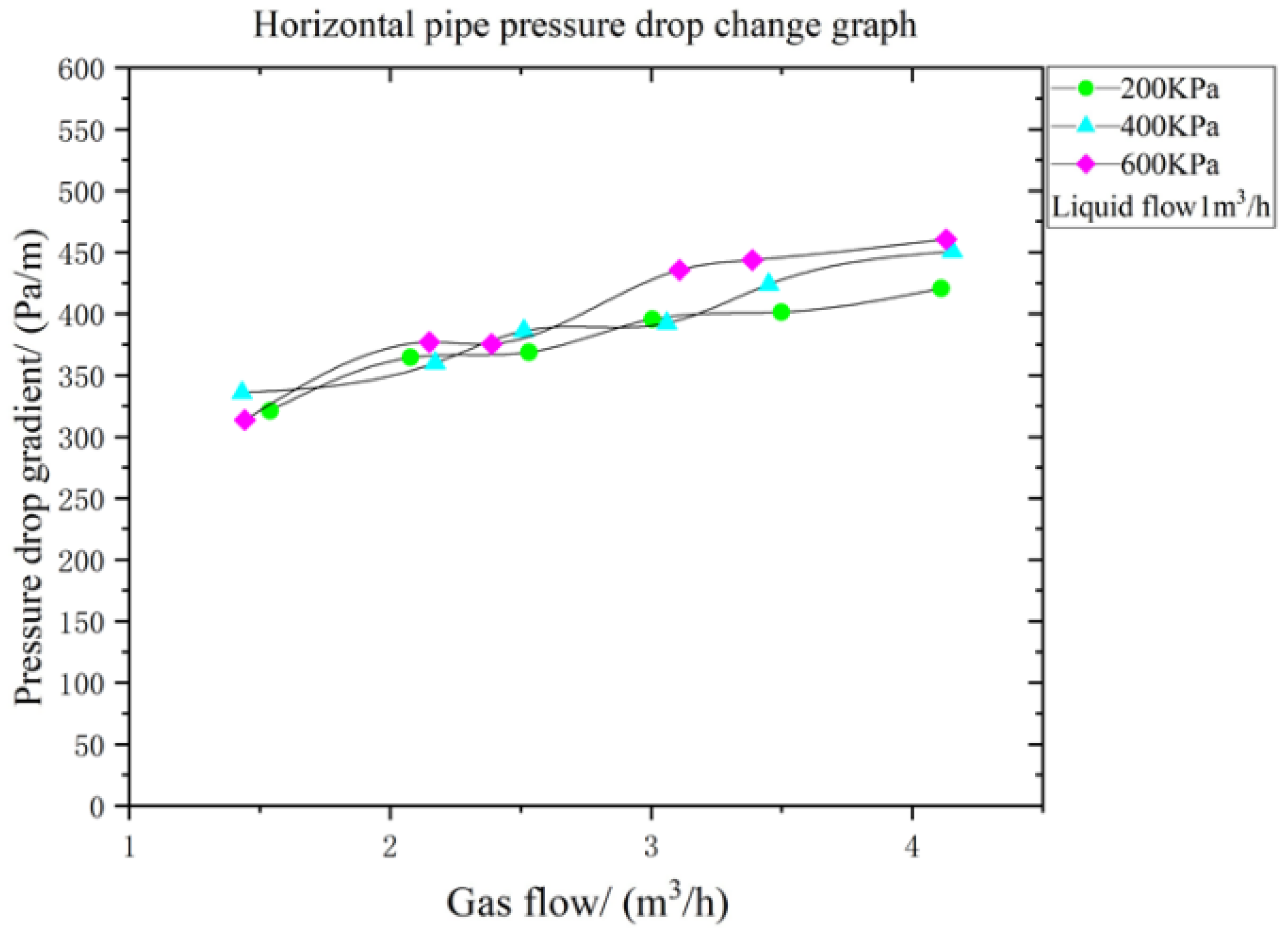

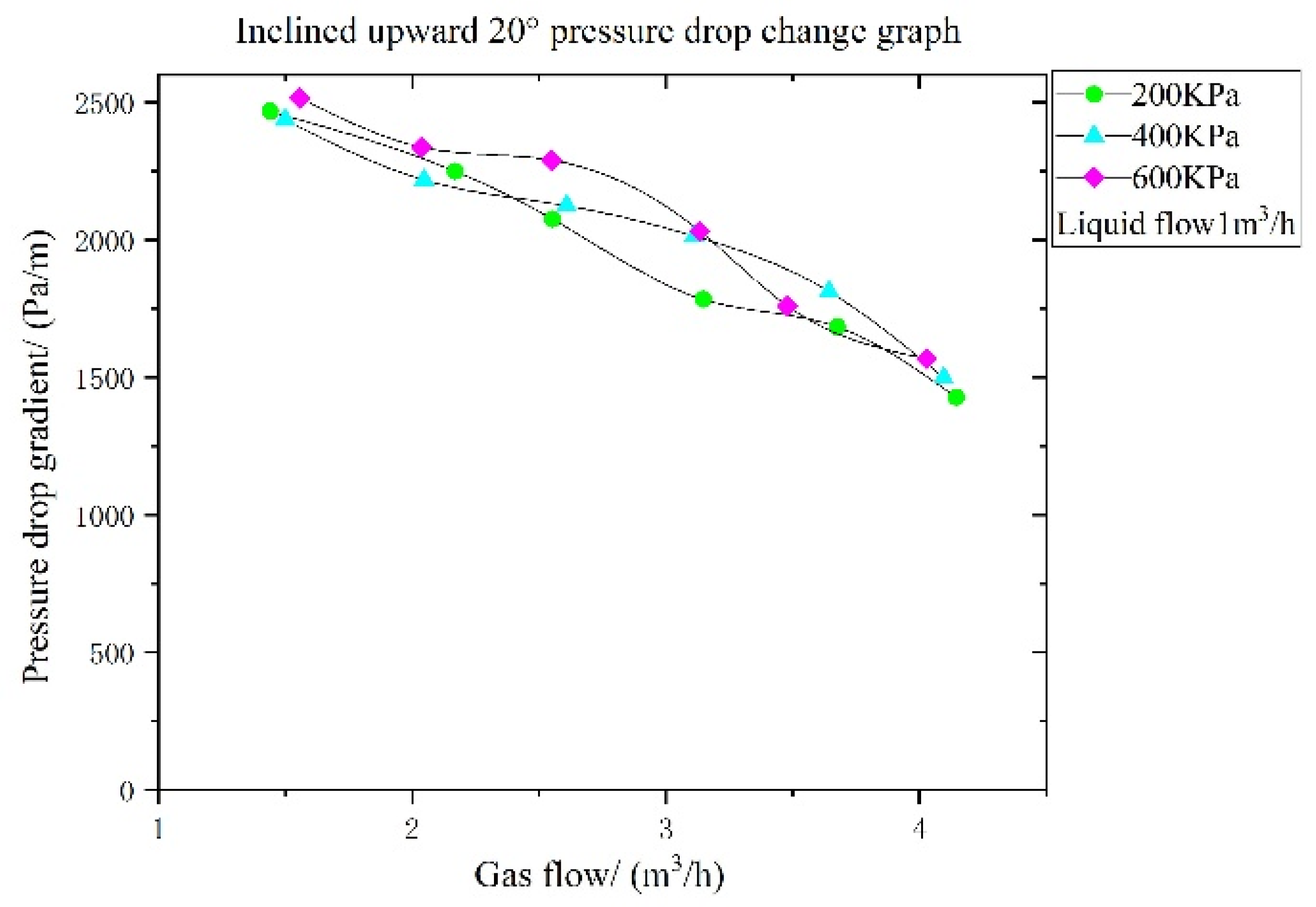
| Pressure | 1.5 m3/h | 2 m3/h | 2.5 m3/h | 3 m3/h | 3.5 m3/h | 4 m3/h |
|---|---|---|---|---|---|---|
| 0.15 MPa | Stratified flow | Stratified flow | Stratified flow | Stratified flow | Stratified flow | Stratified flow |
| 0.2 MPa | Stratified flow | Stratified flow | Stratified flow | Stratified flow | Stratified flow | Stratified flow |
| 0.4 MPa | Stratified flow | Stratified flow | Stratified flow | Stratified flow | Stratified flow | Stratified flow |
| 0.6 MPa | Stratified flow | Stratified flow | Stratified flow | Stratified flow | Stratified flow | Stratified flow |
| Pressure | 1.5 m3/h | 2 m3/h | 2.5 m3/h | 3 m3/h | 3.5 m3/h | 4 m3/h |
|---|---|---|---|---|---|---|
| 0.15 MPa | Slug flow | Slug flow | Slug flow | Slug flow | Slug flow | Slug flow |
| 0.2 MPa | Slug flow | Slug flow | Slug flow | Slug flow | Slug flow | Slug flow |
| 0.4 MPa | Slug flow | Slug flow | Slug flow | Slug flow | Slug flow | Slug flow |
| 0.6 MPa | Slug flow | Slug flow | Slug flow | Slug flow | Slug flow | Slug flow |
| Pressure | 1.5 m3/h | 2 m3/h | 2.5 m3/h | 3 m3/h | 3.5 m3/h | 4 m3/h |
|---|---|---|---|---|---|---|
| 0.15 MPa | Slug flow | Slug flow | Slug flow | Slug flow | Slug flow | Slug flow |
| 0.2 MPa | Slug flow | Slug flow | Slug flow | Slug flow | Slug flow | Slug flow |
| 0.4 MPa | Slug flow | Slug flow | Slug flow | Slug flow | Slug flow | Slug flow |
| 0.6 MPa | Slug flow | Slug flow | Slug flow | Slug flow | Slug flow | Slug flow |
Publisher’s Note: MDPI stays neutral with regard to jurisdictional claims in published maps and institutional affiliations. |
© 2021 by the authors. Licensee MDPI, Basel, Switzerland. This article is an open access article distributed under the terms and conditions of the Creative Commons Attribution (CC BY) license (https://creativecommons.org/licenses/by/4.0/).
Share and Cite
Wang, B.; Hu, J.; Chen, W.; Cheng, Z.; Gao, F. Flow Pattern and Resistance Characteristics of Gas–Liquid Two-Phase Flow with Foam under Low Gas–Liquid Flow Rate. Energies 2021, 14, 3722. https://doi.org/10.3390/en14133722
Wang B, Hu J, Chen W, Cheng Z, Gao F. Flow Pattern and Resistance Characteristics of Gas–Liquid Two-Phase Flow with Foam under Low Gas–Liquid Flow Rate. Energies. 2021; 14(13):3722. https://doi.org/10.3390/en14133722
Chicago/Turabian StyleWang, Bin, Jianguo Hu, Weixiong Chen, Zhongzhao Cheng, and Fei Gao. 2021. "Flow Pattern and Resistance Characteristics of Gas–Liquid Two-Phase Flow with Foam under Low Gas–Liquid Flow Rate" Energies 14, no. 13: 3722. https://doi.org/10.3390/en14133722
APA StyleWang, B., Hu, J., Chen, W., Cheng, Z., & Gao, F. (2021). Flow Pattern and Resistance Characteristics of Gas–Liquid Two-Phase Flow with Foam under Low Gas–Liquid Flow Rate. Energies, 14(13), 3722. https://doi.org/10.3390/en14133722







